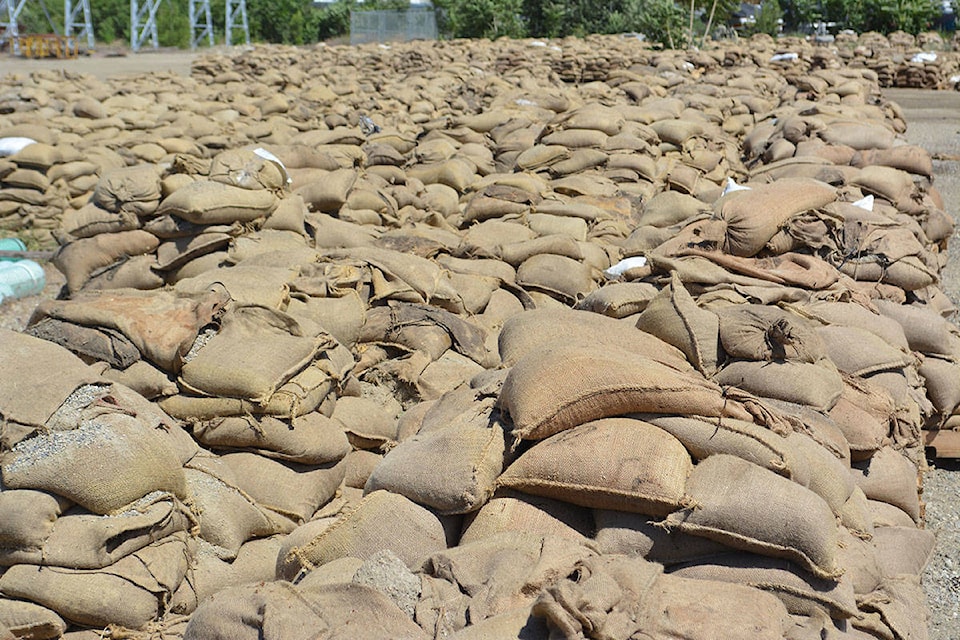With thousands of sandbags along lakes and creeks, disposal plans are moving ahead.
The Regional District of North Okanagan will soon start accepting sandbags at landfills in Lumby, Armstrong-Spallumcheen and Greater Vernon.
”We’re not really sure how much we will receive,” said Dale Danallanko, recycling and disposal facilities operations manager.
Each of the local municipalities is developing their own plans for removal of the sandbags deployed in their jurisdictions. RDNO is then working with the municipalities and the Okanagan Indian Band to co-ordinate receipt and processing of bags at the landfills.
It’s not known if municipalities will have collection stations, but residents can also take the bags directly to the landfills.
“When people take them out of service, they can bring them to the landfill at no charge,” said Danallanko, adding that a firm date for collection has not been established yet.
Once at the landfills, the bags will be opened and the sand used for fill.
“Sand makes very good cover,” said Danallanko.
There are several options to dispose of the sandbags used during the 2017 flooding event once the threat of flood is over. Some sandbags may be considered slightly contaminated with either flood water, spills or unknown sand source, therefore disposal at an approved location or regional landfill is the best choice. Alternatively, if the sandbags have not been exposed to flood water and the source of the sand is known to be uncontaminated, the bags could be emptied onto your private property well away from water bodies, parks, public land and environmentally sensitive ecosystems.
Properties not located in Electoral Areas B, C, D, E and F that have sandbags and other flood debris requiring disposal can contact their municipal office or refer to their websites for information on sandbag and debris disposal options. Collection programs are being coordinated by individual municipalities within the next week.
SANDBAG HANDLING GUIDELINES
The following are general guidelines for the handling of sandbags:
1. Gloves and proper footwear should be worn when handling sandbags.
2. After handling sandbags wash exposed body parts with soap and water and launder clothing.
3. Wet sandbags will be at least twice as heavy as dry sandbags therefore caution should be used or assistance should be sought for lifting the bags.
4. In accordance with Provincial regulations, sand from sandbags must not be placed directly into or adjacent to streams, lakes, ponds, rivers, creeks, springs, ravines, gulches, or wetlands whether or not they contain water.
5. For sandbags that are suspected of containing Hazardous Waste or Dangerous Goods, before handling, call the RDNO for a list of contractors specializing in hazardous waste management. These sandbags will not be accepted at RDNO landfills.
6. Both cloth (e.g. burlap or canvas) and plastic (e.g. woven polypropylene) sandbag sacks must be disposed of or recycled in an appropriate manner.
7. Be careful when beginning a clean-up. Be aware of physical, microbiological, and chemical hazards. For more information refer to HealthLink BC: http://www.healthlinkbc.ca/healthfiles/hfile20.stm
RDNO DISPOSAL FACILITIES AND FEES
Loads of sandbags and/or sand will be accepted free of charge at all RDNO Recycling and Disposal Facilities (RDFs) as long as they are not mixed with any other substance, garbage or recycling materials.
Customers delivering sandbags to the Greater Vernon, Armstrong/Spallumcheen or Lumby RDFs are required to place the bags and/or sand in designated locations at each of the sites. Burlap sandbags and plastic sandbags will be stockpiled separately.
Sandbags may be disposed of at no charge; however, customers must report to the scale prior to disposing of the sandbags. A list of disposal facilities and hours of operation is available on the RDNO website: www.rdno.ca/index.php/services/engineering/solid-waste/garbage/rdf-hours locations.
To determine the fees for other flood debris and regular garbage and recycling refer to the Municipal Solid Waste Management Bylaw No. 2659, 2014 on the RDNO website: http://www.rdno.ca/index.php/documents/bylaws/, Schedule “A”.
For information on Disaster Financial Assistance for the flooding event, please refer to the Provincial website: www2.gov.bc.ca/gov/content/safety/emergency-preparedness-response-recovery/emergency-response-and-recovery/disaster-financial-assistance.
For further information, please contact the RDNO office at 250-550-3700.
